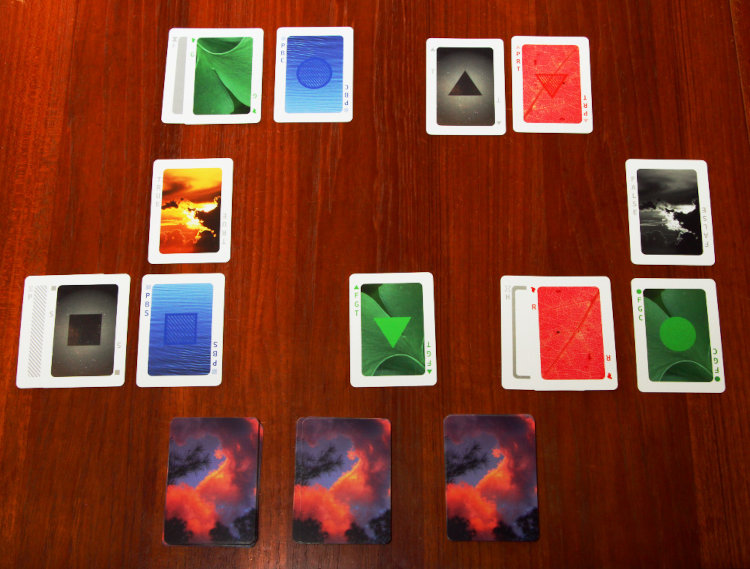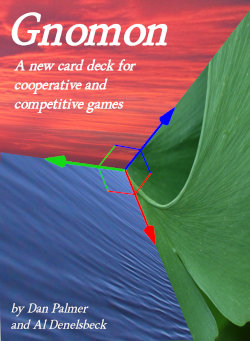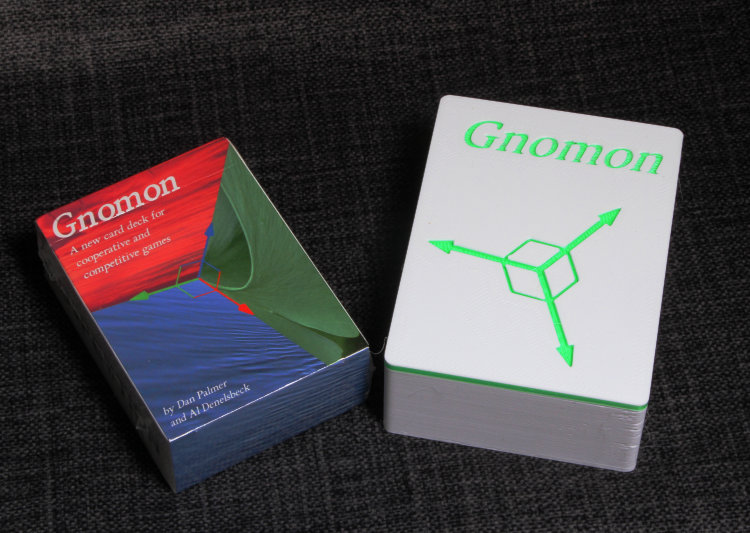This is part two of the sordid mess; part one can be found here.
So with the design of the deck largely locked down, we had two main challenges, which don’t seem like they should be hard: creating games for the deck, and finding a name for it. Dan Palmer already had a few games past the conceptual stage and started play-testing a couple, but such things need refinement to find any issues, and they also need to be written out in clear form, easy to interpret and explain to the other players. If you’ve never tried this, I call tell you that it’s a lot harder than it seems, and writing clear, concise game rules is a skill that neither of us are adept at. I was probably a bit of a thorn in Dan’s side, in that I’m not fond of learning games through instructions in the first place, I don’t know why, and I kept kicking things back to him with various comments about reducing text and clarifying goals. I won’t say that, at this point, we have the rules where they ‘should’ be (whatever definition of that applies,) but they’re better than the first drafts for sure.

There’s also play-testing, and this was problematic for both of us. I have extremely limited access to people who want to try card games, and in nine months managed two or three sessions of a round or two each, plus my playing alone as multiple players, and that was it. Dan had an advantage while college was in session in that he was connected to a group of gamers and could occasionally get a game into play, and in fact it was because of this that we received our first real encouragement. Some weeks after a test round, Dan was contacted by one of the players asking him where he’d gotten the deck, since the player had been all over the internet trying to get his own copy and had come up blank; no surprise, since it wasn’t in production yet. But it was great to hear both that he wanted one, and that he thought it was actually a professional product.
Which kind of segues into the second aspect, which was what to name it. There are a lot of considerations here, among them that it be unique and not already copyrighted (or too close to something that was,) that it not have undue associations, and that it described the deck in a useful and preferably clever manner. This went on for a surprisingly long time, but it’s where I get to relate the amusing interchange that took place over the course of several weeks.
Having noticed that all of Dan’s games (there were now several) began with the letter ‘C,’ I impishly suggested that we name it “C-Word.”
“I’m not naming the deck, ‘C-Word,'” Dan maintained strenuously.
“No, but we call it, ‘Seaward,’ instead – that’s not dirty,” I protested.
“But then we have to explain what it means,” Dan returned, “otherwise it makes no sense.”
“So we give the meaning someplace in the rulebook. After all, the games do all start with ‘C,'” I maintained.
“I’m not naming the deck, ‘Seaward,'” Dan semi-repeated [this is all paraphrased of course, but you get the gist.]
Nonetheless, I continued to refer to it as the Seaward deck, even giving that name to the resource folder on my computer. Dan on the other hand, at a loss when he needed to refer to it, simply began calling it the, “Benels Deck,” a play on my last name, so much so that his play-testing group started referring to it that way. There wasn’t a chance that we’d keep this of course, since it failed to meet any of the criteria save for being unique. Plus I’d had enough wordplay on my name in school (imagine that,) even though this was innocuous.
We rejected a couple of inside jokes, and I recall at one point suggesting “Sea Urchin” – it was an animal with nine unique letters, which references the categories within the deck, plus it worked “sea” back in there. This was quashed quickly when we found it was already an entry in Urban Dictionary – not copyrighted, but the association wasn’t ideal. We also both had a go at using the first letters of all of the categories within the deck: R, G, B, F, P, H, C, S, T. You’ll notice a shortage of vowels in there, so obviously we couldn’t use just those letters (unless we went with Welsh,) but they never produced a useful, even made up, name anyway.
It was getting down to the wire: the conference was in a few weeks, and we wanted to have a reference to some of the games available as a link; we ended up producing a temporary sub-domain just to have some stuff handy for the people who were reading the paper before the conference. I should explain in better detail: Dan had written a paper on the dimensions and possibilities of the deck for this year’s Bridges Conference on mathematical connections in art, music, architecture, and culture. He had attended last year’s and felt this would be a good fit. The paper was accepted, and the comments on it were encouraging, but this meant that we had to be more prepared than we were, and this is part of the fun of game design. You might have a good idea, but what do you do with it? Crowd-funding? Gain the interest of a major production company? Market it yourself (e.g., Etsy)? People expect games to have rulebooks and promotional materials and slick little boxes and even, hard as it may be to believe, names, and we had none of that.
 In the eleventh hour, Dan suggested “Gnomon” as the name choice, and it stuck. A gnomon is a three-dimensional representation, both as a shaft or column rising from a plane (which is why the shadow-casting piece of a sundial is named that,) and as the pointer within 3D software that helps represent and indicate the third dimension within the confines of a computer screen. Moreover, it wasn’t taken by anyone including web domains, had no bad associations that we ever found, and was unique. Within two days, we had the domain secured and the graphics of the tuck box for the new decks designed and ready to print. This was less than a month before the conference and we needed two weeks lead time to get a new run of cards printed.
In the eleventh hour, Dan suggested “Gnomon” as the name choice, and it stuck. A gnomon is a three-dimensional representation, both as a shaft or column rising from a plane (which is why the shadow-casting piece of a sundial is named that,) and as the pointer within 3D software that helps represent and indicate the third dimension within the confines of a computer screen. Moreover, it wasn’t taken by anyone including web domains, had no bad associations that we ever found, and was unique. Within two days, we had the domain secured and the graphics of the tuck box for the new decks designed and ready to print. This was less than a month before the conference and we needed two weeks lead time to get a new run of cards printed.
Meanwhile, I was amusing myself by attempting some video, primarily of a play-through of one of the games, as a demo and proof-of-concept. It wouldn’t be for the conference, but successful videos would serve as promotional material, be available to help explain the rules, and would be necessary if we were to go the crowd-funding route. Even setting this up was a little tricky, since the camera had to have a clear and focused view of the entire playing field, and the lighting had to be adequate and even enough while not throwing glare from the surfaces of the cards; thankfully I had a heavy-duty lightstand and lateral arm to suspend the camera directly over the playing surface. It became clear, as suspected, that one-camera, one-take wasn’t going to work; we’d need close-ups from time to time, and separate audio voiceover was going to be a lot cleaner and smoother (especially when I was forgetting how certain rules went as I was dealing in front of the camera.)

Meanwhile, the new order of card decks with the tuck boxes had arrived, and they looked great – one could, if they squinted, almost believe that we knew what we were doing. And so they were available at the conference, for both demonstrations and sales, of which we made a few. Unfortunately, due to demands on time for both Dan and I, further progress is stalled for the moment – I expect to be able to do more after September at least, but for Dan it will be when he can squeak out a few minutes amongst other tasks. Still, we’re this far along and it isn’t going to stop now. Look for Gnomon at your local game retailer, oh, say, this time next year? Perfect for christmas buying, or all those people you know whose birthday is in September. And if you want one sooner, contact us.




















































